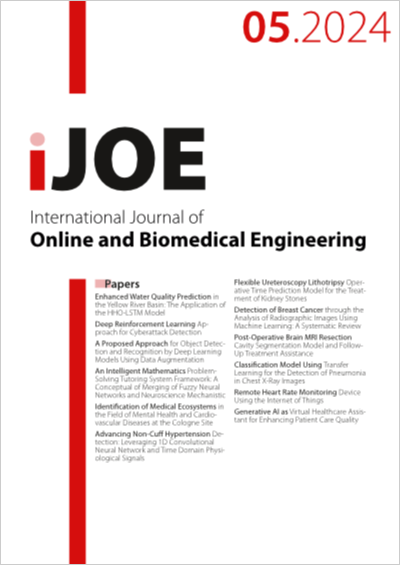Classification Model Using Transfer Learning for the Detection of Pneumonia in Chest X-Ray Images
DOI:
https://doi.org/10.3991/ijoe.v20i05.45277Keywords:
Classification models, Transfer learning, Convolutional neural networks, Pneumonia, Data augmentation, Image Data GeneratorAbstract
In the current global context, there has been a significant increase in respiratory system diseases, particularly pneumonia. This disease has a higher incidence of mortality in children under five years old and adults over 60 years old because it leads to complications if not treated in time. This research leverages convolutional neural networks (CNNs) to classify images, specifically to detect the presence of pneumonia. The data processing methodology utilized in this study is CRISP-DM. The dataset consists of 5,856 images of anteroposterior chest X-rays downloaded from the open repository “Kaggle,” divided into 5,216 images for training, 16 for validation, and 624 for testing. Preprocessing involved image augmentation through modifications to the original images, scaling, and batch division in tensor format. A comparative analysis was conducted among the transfer models: DenseNet, VGG19, and ResNet50 version 2. Each transfer model was the header of a CNN with four subsequent layers. The models underwent training, validation, and testing phases. The test’s results showed that DenseNet achieved an accuracy of 0.87, VGG19 achieved 0.86, and ResNet50 achieved 0.91. These results affirm the effectiveness of ResNet50 in image classification, considering that the model’s output is binary, where 0 represents that the patient does not have pneumonia and 1 indicates that the patient has pneumonia.
Downloads
Published
How to Cite
Issue
Section
License
Copyright (c) 2024 Gisella Luisa Elena Maquen-Niño, Jhojan Genaro Nuñez-Fernandez, Fany Yesica Taquila-Calderon, Ivan Adrianzén Olano, Mg. De-La-Cruz-VdV, Gilberto Carrión-Barco

This work is licensed under a Creative Commons Attribution 4.0 International License.



